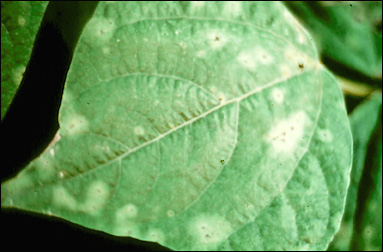Blights, diseases that cause plant death
 This is where parts of a plant (eg. leaves) stop growing and die, often without rotting (rotting may occur later).
This is where parts of a plant (eg. leaves) stop growing and die, often without rotting (rotting may occur later).
A blight is generally sudden, and commonly involves death of parts of a plant, and sometimes dropping of leaves or fruit.
Types of Blights:
Blights are often named according to the part of the plant they infect and the plant variety they occur on: eg. Azalea Petal Blight is a blight where dead tissue develops on the petals of azalea flowers.
Control: Hygiene is most important for all blights.
Remove and burn all infected tissue as soon as detected.
Copper-based sprays will help control most blights, though some require other specific chemical sprays.
Alternaria (Blight)
There are different varieties of this disease which cause both blights and leaf spots.
Sometimes the leaf spot and blight effects appear together.
Plants affected: Cucurbits, Carnations, Carrots, Potato, Tomato, Violet, Zinnia, Umbrella tree (Scleffera), Ivy, Aralia.
Control: Zineb, Ziram, Copper-based sprays
Bacterial Blight (Pseudomonas syringae)
On Mulberry, the disease (Pseudomonas syringae pv. mori) first affects young leaves as they burst form the bud. This causes blackened dead edges to the leaf resulting in leaf distortion. The surrounding area is yellowed.
Control: remove infected leaves and spray with a copper based fungicide.
On Peas, the disease (Pseudomonas syringae pv. pisi) is common in cool to warm, damp conditions, entering the plant through damaged tissue or stomatas. Damage parts first appear to be water soaked, but then change to dark brown. On pods the damage is usually kept to the edges.
Control: Destroy infected plants. Use disease-free seed. Rotate crop on a three year cycle.
Fire Blight (Apple & Pear)
Fire blight has not been recorded in Australia to date. It is a bacterial disease causing fruit to die soon after petal-fall, and affected leaves to go brown and remain on the tree. There are strict quarantine controls on fruit imported from places known to have fire blight.
Halo Blight (Beans)
On leaves: The bacterium (Pseudomonas phaseolicola) causes small angular brown spots surrounded with a lime halo. Wilting and stunting of leaves may occur.
On stems: Elongated, dark green water-soaked areas occur.
On pods: Circular spots with greasy spot centres.
Cool showery weather increases infestation.
Control: Destroy diseased crops immediately after harvest, use only disease-free seed and reduce traffic between infected crop and non-infected areas.
Leaf Blight
Leaves may develop spots or patches of dead tissue. The leaves may drop, or may hold on the plant. The dead areas may spread to other parts of the plant, and might become larger. A number of different fungi can cause leaf blight.
Plants Affected: A large variety of different types of plants can be affected.
Control: Spray with Copper-based sprays, or Zineb when leaf buds are half open and again when leaves are half grown to full size.
Petal Blight
Petals discolour and rot, resulting in a slimy brown mass. In time this mass dries out and becomes papery and brown. They remain connected to the plant unlike healthy flowers that fade then fall off. If the humid weather continues, black seed like bodies, up to 4mm wide, called sclerotia may develop, which can cause future infection in the following seasons. This disease should not be confused with grey mould where petals may only rot, without the presence of the sclerotia. Failure to correctly identify the fungus can result in unsuccessful fungicide application. This fungus is most common on Rhododendrons spp. primarily on Kurume and Indica azaleas. It may also infect Kalmia spp.
Shoot Blight
On Eucalyptus: the disease (Ramularia pitereka) is prevalent in cool shady moist environments with poor air circulation. Small spots (brown with thin purplish brown margin) develop on one edge of leaves causing distortion. Leaves frequently appear shiny white. Sunken brown areas may develop on the stems and petioles.
Control: Use copper-based sprays. Improve environmental conditions such as ventilation.
On pines: the disease (Diplodia pinea) caused brown necrotic areas at the ends of branches. Attack is more common on weakened trees.
Control: use copper-based sprays.
Shot Hole (Blight)
On snapdragons: the disease (Heteropetella antirrhini) prefers cool moist conditions, and is spread by spores on seed and plant parts. Initially the damage is seen as pale yellow spots, which then develop into holes with purplish edges. Plants may look scorched.
Control: use fungicides such as copper-based sprays or zineb. Do not collect seed from infected plants.
On stone fruit: the disease (Stigmina carpophila) causes small spots with reddish edges on leaves, on which the centre eventually falls out resulting in a hole. On fruit the damage appears as raised brown rough scabs that frequently exude gums.
Control: this fungus often overwinters on twigs then becomes active in the warmer, wet rains in spring. Spray with copper oxychloride with the addition of white oil at flower opening, leaf fall and again at pruning.
Want to Learn More?
Check out publications in the ACS Bookshop: www.acsbookshop.com
For more information on Courses on Pests & Diseases:
In Australia: http://www.acs.edu.au/Courses/General-Horticulture-courses.aspx
In the UK: http://www.acsedu.co.uk/Courses/General-Horticulture-Courses.aspx
You may also be interested in....